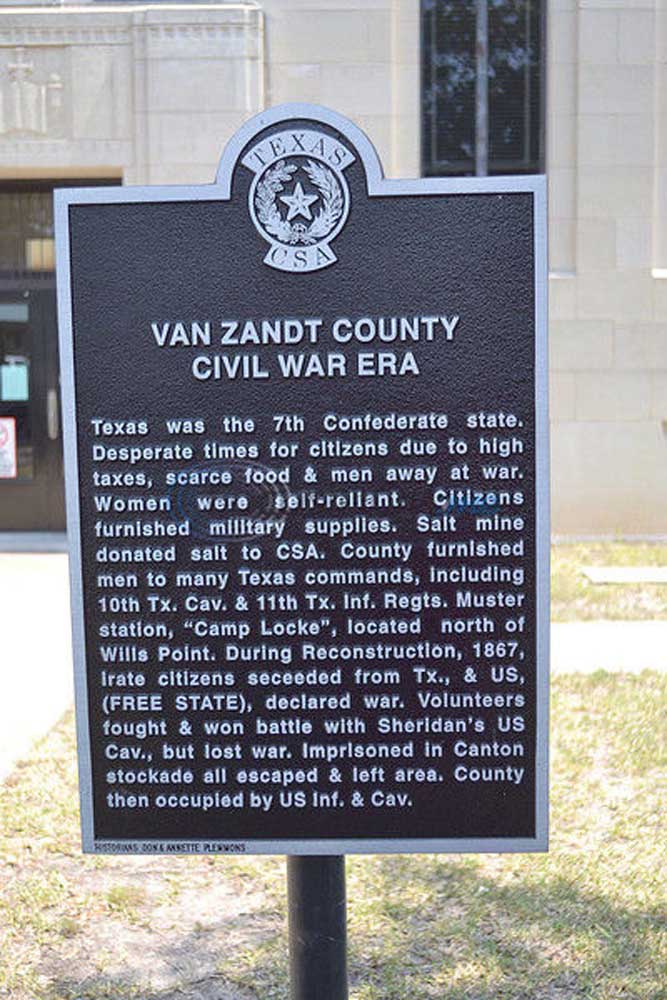‘Free state of Van Zandt’ chronicled
Published 11:05 pm Sunday, September 1, 2013

- Faith Harper/ Staff
A historical marker resting on the west end of the Van Zandt County Courthouse chronicles the existence of the “Free State of Van Zandt” during the Civil War era, but the details of how the county acquired the designation has become folklore.
Elvis Allen, with the Van Zandt County Historical Commission, said the marker was put up in the 1990s, and it is not an official State of Texas historical marker, donning “Texas CSA” at the top for Confederate States of America. The marker has never been authenticated, he said.
Allen said there are wildly different versions of how the term came to be, but the most likely account came after the Civil War during reconstruction.
“According to the legend, after the reconstruction period the U.S. military was in here, and there were a bunch of ex-rebels causing trouble in Van Zandt County,” he said. “They attacked the U.S. military south of Canton, they went back to Canton, got drunk and declared Van Zandt was a free state.”
Allen said at the time, the Bureau of Refugees, Freedmen and Abandoned Lands, commonly referred to as the Freedmen’s Bureau, was in the area helping ex-slaves get jobs, reunite with family members and sign up for the census.
The bureau’s presence and the military backing that followed them was met with resistance, and rebels began attacking mail carriers and doing other hostile acts, Allen said.
Official telegrams sent from the Canton post to Austin chronicled a run-in between the two in the winter of 1869.
Five rebels attacked a group of Union soldiers near the town of Jordan’s Saline, south of modern-day Grand Saline. According to telegrams, the rebels shot at the soldiers from the woods, and the soldiers dismounted their horses to fire back. No one was injured in the exchange, and five men were arrested for the crime.
The captured men were put in shackles attached to heavy logs in a prison south of Canton, according to according the book “History of Van Zandt County” by William Samuel Mills.
“The Free State boys were model prisoners, somewhat enjoying the army food,” Mills wrote.
The men were watched by armed guards but escaped. One man broke free from his chains using an undiscovered knife in his boot as a file in his boot, Mills said.
The lot broke free by throwing their bodies against the logs and pulling them from the ground during the rainy season when the soil became soft from rainfall, according to Mills.
The term also may be coined from the county’s resistance to participate in the Civil War, according to an account by Orville Rice published in the Canton Telephone in January 1893.
The article states the county had a large number of Unionists, and residents asserted if the state could leave the Union, then the county could leave the state. They “issued an ordinance of defiance, and declared the people of Van Zandt were free and independent and acknowledged no government save one of their own making.”
According to the account, troops were sent to wipe out the rebellion, which showed “how utterly weak and helpless the new state was, and the idea of the Free State of Van Zandt was abandoned.”
The name is also rumored to been coined during the separation of Van Zandt County from a portion of Henderson County in 1848, according to Mills.
Mills said the term could have referred to the county’s lack of indebtedness to Henderson County. He said it was called a “free territory” because of the lack of taxation and debt, but the term could have evolved into the free state. Allen said this tale was proven false by receipts showing Van Zandt, in fact, did pay an amount to Henderson County after their split.
Allen said the “Free State of Van Zandt” was not mentioned often before the turn of the century with the invention of the telephone and other communication devices, after which the term “free state” was often used in advertisements.
“An Earnest endeavor has been made to determine just how the term ‘Free State of Van Zandt’ came to be applied to our county, but the deeper the research the more baffling the question became,” Mills wrote.






